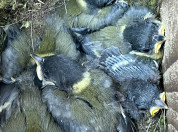Droevendaalsesteeg 10
6708 PB Wageningen
The Netherlands
How does seasonality in the timing of environmental stressors affect animals and their persistence, from individuals to populations?
I joined the Department of Animal Ecology at NIOO-KNAW in September 2022. My research focusses on understanding how wildlife respond to environmental change, with a particular eye to the role that seasonality plays in shaping the lives of animals. I take an integrative approach to studying these questions, looking at how changes in individual traits like morphology, behaviour, and physiology scale up to affect the dynamics of populations and communities of birds. My work is centred on the fantastic long-term studies of hole-nesting passerines carried out by researchers at NIOO-KNAW since 1955. These extensive time series —some of the longest in the world— offer amazing opportunities to understand how avifauna have and continue to adapt to an ever-changing world.
I completed my B.Sc. at the University of British Columbia in Vancouver, where I was fortunate to get an early start in research working on threespine stickleback. Next, I traded the majestic scenery of the Coast Mountains for the beautiful streets of Amsterdam, where I completed my M.Sc. at the University of Amsterdam in 2016. During my first stint in the Netherlands is when my passion for birds really took flight through my work with Dr. Judy Shamoun-Baranes (UvA) studying differential migration in lesser black-backed gulls and Drs. Kimberly Mathot and Eva Kok exploring behavioural ontogeny in red knots at the Royal Netherlands Institute for Sea Research (NIOZ). I returned to Canada to complete my Ph.D. working with Dr. Ryan Norris at the University of Guelph (Ontario), trading birds for the quintessential model species, fruit flies (Drosophila melanogaster). My Ph.D. made use of laboratory populations of flies to examine how the seasonal timing of environmental stressors like habitat loss influences the way in which populations decline. I was also able to continue working with birds through collaborating on the long-term demographic study of Savannah sparrows breeding on Kent Island, a fog-swept island in the Bay of Fundy (New Brunswick). There, I gained a deeper appreciation for the struggles of studying animals in the wild and a greater understanding of the nuances field observations can bring to the questions we ask. I finished my Ph.D. in the depths of the Covid-19 pandemic and was lucky to land a postdoctoral position with the inspiring Living Data Project, an offshoot of the Canadian Institute of Ecology and Evolution (CIEE), which trains graduate students in open science best practices and partners with data stewards to help preserve valuable, yet inaccessible, environmental data.




